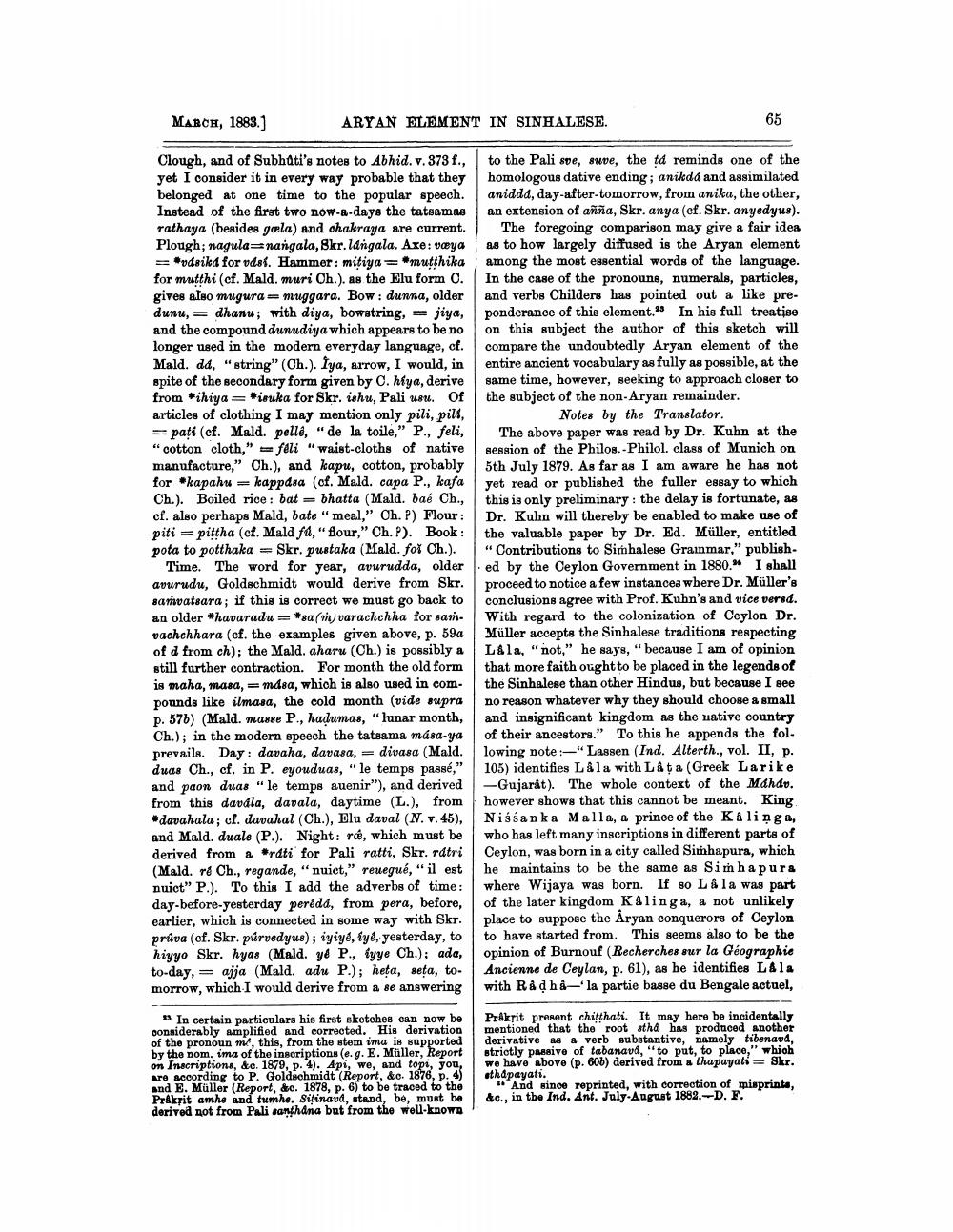________________
MARCH, 1889.)
ARYAN ELEMENT IN SINHALESE.
Clough, and of Subhati's notes to Abhid. v. 373 f., to the Pali sve, suve, the td reminds one of the yet I consider it in every way probable that they homologous dative ending; anikdd and assimilated belonged at one time to the popular speech. anidda, day-after-tomorrow, from anika, the other, Instead of the first two now-a-days the tatsamas an extension of añña, Skr. anya (cf. Skr. anyedyus). rathaya (besides gæla) and chakraya are current. The foregoing comparison may give a fair idea Plough; nagula=nangala, Skr. langala. Axe: væya as to how largely diffused is the Aryan element = *vdsikd for udsk. Hammer: mitiya=*mutthika among the most essential words of the language. for mutthi (cf. Mald. muri Ch.). as the Elu form C. In the case of the pronouns, numerals, particles, gives algo mugura muggara. Bow: dunna, older and verbs Childers has pointed out a like predunu, dharu; with diya, bowstring, = jiya, ponderance of this element. In his full treatise and the compound dumudiya which appears to be no on this subject the author of this sketch will longer used in the modern everyday language, cf. compare the undoubtedly Aryan element of the Mald. dd, "string" (Ch.). Iya, arrow, I would, in entire ancient vocabulary as fully as possible, at the spite of the secondary form given by C. hiya, derive same time, however, seeking to approach closer to from ihiya = *isuka for Skr. ishu, Pali usu. Of the subject of the non-Aryan remainder. articles of clothing I may mention only pili, pill,
Notes by the Translator. = pati (cf. Mald. pelle, " de la toile," P., feli, The above paper was read by Dr. Kuhn at the "cotton cloth," feli "waist-cloths of native session of the Philos.-Philol. class of Munich on manufacture," Ch.), and kapu, cotton, probably 5th July 1879. As far as I am aware he has not for kapahu = kappdsa (of. Mald. capa P., kafa yet read or published the fuller essay to which Ch.). Boiled rice: bat = bhatta (Mald. baé Ch., this is only preliminary: the delay is fortunate, as cf. also perhaps Mald, bate" meal," Ch.P) Flour: Dr. Kuhn will thereby be enabled to make use of piti = pittha (cf. Mald fa," flour," Ch.P). Book: the valuable paper by Dr. Ed. Müller, entitled pota to potthaka = Skr. pustaka (Mald. for Ch.). "Contributions to Simhalese Grainmar," publish
Time. The word for year, avurudda, older |ed by the Ceylon Government in 1880." I shall avurudu, Goldschmidt would derive from Skr. proceed to notice a few instancea where Dr. Müller's sanatsara; if this is correct we must go back to conclusions agree with Prof. Kuhn's and vice verad. an older "havaradu #sa(h)varachchha for sam- With regard to the colonization of Ceylon Dr. vachchhara (cf. the examples given above, p. 59a Müller accepts the Sinhalese traditions respecting of d from ch); the Mald. aharu (Ch.) is possibly a L&la, "not," he says, "because I am of opinion still further contraction. For month the old form that more faith ought to be placed in the legends of is maha, masa, mdoa, which is also used in com- the Sinhalese than other Hindus, but because I see pounds like ilmasa, the cold month (vide supra no reason whatever why they should choose a small p. 576) (Mald. masse P., hadumas, "lunar month, and insignificant kingdom as the native country Ch.); in the modern speech the tatsama mása-ya of their ancestors." To this he appends the fol. prevails. Day: davaha, darasa, = divasa (Mald. lowing note: -"Lassen (Ind. Alterth., vol. II, p. duas Ch., cf. in P. eyouduas, "le temps passé," 105) identifies Lala with Låta (Greek Larike and paon duas " le temps auenir"), and derived -Gujarat). The whole context of the Mahdo. from this davala, davala, daytime (L.), from however shows that this cannot be meant. King • davahala; cf. davahal (Ch.), Elu daval (N. v. 45), Nissanka Malla, a prince of the Kalinga, and Mald. duale (P.). Night: re, which must be who has left many inscriptions in different parts of derived from a rdti for Pali ratti, Skr. rdtri Ceylon, was born in a city called Simhapura, which (Mald.ro Ch., regande, "nuict," reuegué, "il est he maintains to be the same as Simhapura nuict" P.). To this I add the adverbs of time: where Wijaya was born. If so L & la was part day-before-yesterday peredd, from pera, before, of the later kingdom Kalinga, a not unlikely earlier, which is connected in some way with Skr. place to suppose the Aryan conquerors of Ceylon priva (cf. Skr. púrvedyus); iyiye, tyd, yesterday, to to have started from. This seems also to be the hiyyo Skr. hyas (Mald. & P., tyye Ch.); ada, opinion of Burnouf (Recherches sur la Géographie to-day, = ajja (Mald. adu P.); heta, seta, to Ancienne de Ceylan, p. 61), as he identifies Lala morrow, which I would derive from a se answering with Rådhå-la partie basse du Bengale actuel,
* In certain particulars his first sketches can now be considerably amplified and corrected. His derivation of the pronoun ml, this, from the stem ima is supported by the nom, ima of the inscriptions (e.g. E. Müller, Report on Inscriptions, &c. 1879, p. 4). Api, we, and topi, you, are according to P. Goldschmidt (Report, &c. 1876, p. 4) and E. Müller (Report, &o. 1878, p. 6) to be traced to the PrAkpit amha and tumhe. Sitinavd, stand, be, must be derived not from Pali sanchana but from the well-known
Prakrit present chitthati. It may here be incidentally mentioned that the root sth has produced another derivative as a verb substantive, namely tibenaud, strictly passive of tabanavd, "to put, to place," which we have above (p. 60b) derived from a thapayati = Skr. atha payati.
# And since reprinted, with correction of misprinta, &c., in the Ind. Ant. July August 1882.-D. F.




